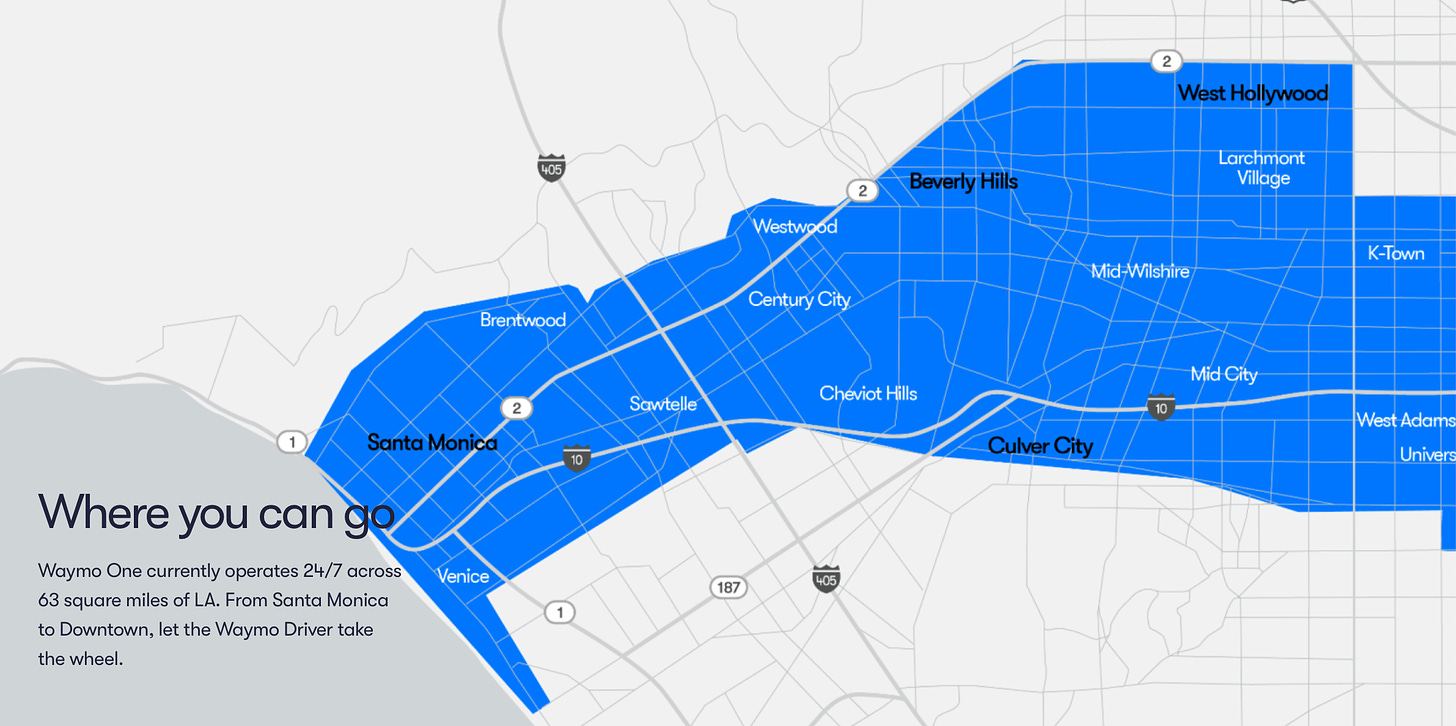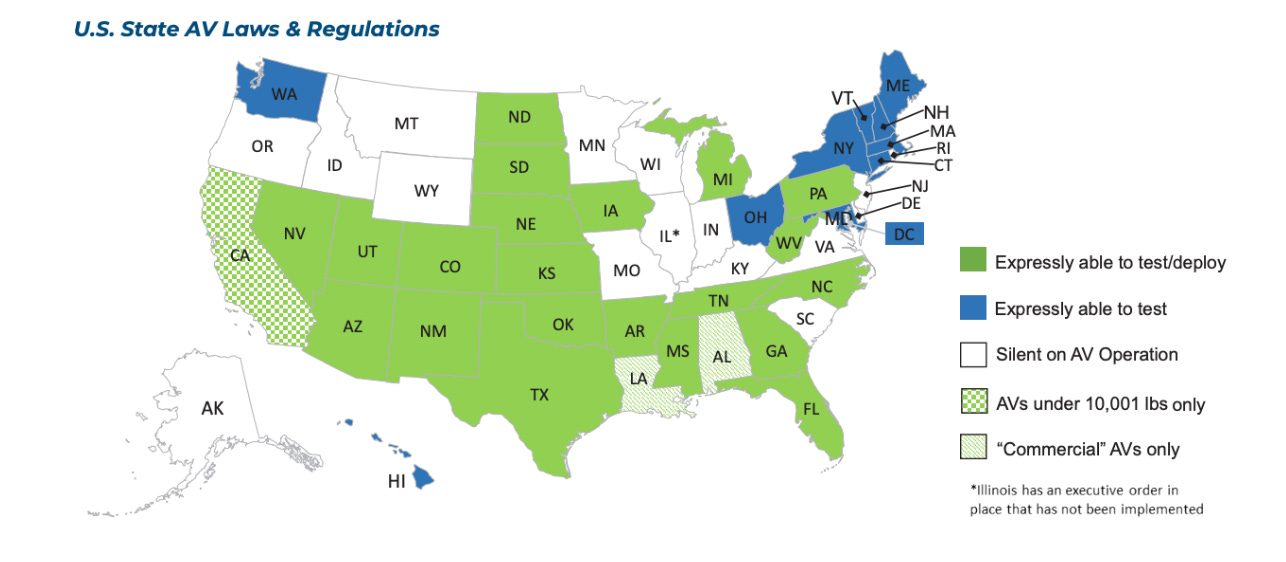The Obama administration saw a flurry of tech sector hype about self-driving cars. Not being a technical person, I had no ability to assess the hype on the merits, but companies were putting real money into it, and so I wrote pieces looking at the labor market, land use, and transportation policy implications. But the tech turned out to be way overhyped, progress was much slower than advertised, and then Elon Musk further poisoned the water by marketing some limited (albeit impressive) self-driving software as “Full Self-Driving.”
That whole experience seems to have left most people with the sense that self-driving cars are 10 years away and always will be.
I am still not a technical person, but at this point I am prepared to make a technical judgment: The current conventional wisdom is wrong and autonomous vehicle technology has become underhyped. The key mistake I’ve noticed people making is they don’t seem to realize that autonomous taxis are no longer a hypothetical future technology. They exist, and you can ride in them. Waymo has been operating in San Francisco and Phoenix for a while now and is expanding soon to Austin and to a sort of awkward-to-describe-accurately swathe of Los Angeles County.
The technology that exists is not without its limits. Waymo’s Driver software relies on detailed local mapping to work, which is not how humans drive cars. As a result, you can’t expand Waymo into an arbitrary geography without a significant capital outlay upfront. That’s a real business model challenge for the company, because this is obviously also a highly regulated space. In purely business terms, what you would want to do is start with the most lucrative geographies to start generating cash flow and only expand out from there. But in practice, Waymo needs to balance where it makes business sense to operate and where they can get permission. What’s more, they seem to only be targeting warm cities, as if they have a known problem with dealing with snow or ice.
So it’s not a solved problem; we’re still talking about a world of hype and potential more than a reality. But the reality is that if you have a business meeting in Downtown Phoenix, you can take a driverless taxi to the airport when you wrap up. Not in the future. Not hypothetically. But right now. We’re looking primarily at questions of business models and economics, not technology. Driverless cars are on the road as we speak, and more are coming in the very near future.
The freeway frontier
One reason that not a lot of people know about the world’s actually existing driverless taxis is that even in the places where they operate, there isn’t actually a good reason to take them.
The big problem is that Waymo’s vehicles aren’t authorized to drive on freeways. That means that in most cases, going somewhere in a Waymo One driverless taxi would be slower than going in an Uber or driving yourself. That’s fun if you’re a curious tourist, a journalist, or just a technophile who enjoys adventure. But what they have is essentially a product that is technically impressive but practically inferior to the existing alternatives. The inability to use freeways is a particularly crippling issue in Phoenix, given its urban design, but San Francisco also has a strong freeway spine for a lot of the most common trips you might want to take. And in San Francisco, the service area doesn’t include the airport, which in every city I’m familiar with is a really important pillar of the taxi market.
Importantly, though, this isn’t because there’s any technical problem with operating driverless cars on freeways.
The somewhat paradoxical thing about city versus freeway driving is that freeway driving is higher-stakes (because the cars are going much faster), but it’s cognitively and logistically easier. In the city, even when everyone is following the rules, you have all kinds of conflicts between moving cars and parking cars, between turning cars and pedestrians, between cars and bikes sharing lanes, and God knows what else. What’s more, it’s just not the case that everyone is following the rules. People unloading trucks double-park all the time. Pedestrians frequently cross mid-block. Cyclists don’t always stop at stop signs. And the rule violations compound in complicated ways: The truck parks in the bike lane, so the cyclist serves into the traffic lane. Because the vehicles are all moving relatively slowly, you’re less likely to have a spectacular crash. But because the situation is more chaotic, it is a much more technically difficult problem.
Regulators have, reasonably, wanted Waymo to demonstrate success with the harder-but-lower-stakes problem before tackling the easier-but-higher-stakes problem.
But Waymo has gotten regulatory permission to expand onto freeways and as far south as Sunnyvale, just outside San Jose. When this service rolls out it will be much more useful than the existing version of Waymo, letting people get rides to the airport and to the major Silicon Valley corporate campuses at reasonable speeds. They are also testing service on Phoenix freeways, which again will make it an actual competitive product that people might want to use for reasons other than curiosity. Meanwhile, I’ve seen humans driving Waymo cars around DC, which is apparently how their buildout works. The point is, driverless cabs are really happening, to a greater extent than most people seem to know.
Subscribe now
Autonomous vehicles could be a huge deal
During the Obama-era AV hype cycle, the prospect of driverless cars was mostly presented as a threat. I remember former SEIU president Andy Stern making a big deal about the possibility that automation would eliminate a lot of truck driver jobs and create a disemployment crisis.
One nice thing about having a moderately inflationary full employment economy is that it helps focus political attention on questions of productivity and growth. It would of course be sad for cab drivers to lose their jobs. But the current American economy has low unemployment and a decent number of job openings, which means they’re likely to find new work. And if driverless cars bring down the price of taxi rides, that reduces inflation, which reduces interest rates and that benefits everyone — in particular, it reduces the cost of investment in the future of the American economy.
Taxi rides are not a particularly large swathe of the Consumer Price Index.
But Stern’s truck drivers are a much bigger deal. The price of much of what we buy is at least in part a function of the cost of shipping, often via truck. More cost-effective shipping would be a huge deal for the economy and a big boost to productivity and disinflation. Again, of course, every lost job is sad for the people who lose their jobs. Which, again, is a reason that it’s good to have a low-unemployment economy. But even better when you consider the implications of making it cheaper to ship stuff, you’re clearly creating more demand for workers at other stages of the process by knocking out part of the cost of doing business.
Another area I’m excited for is the humble city bus. Because a bus runs a fixed route across a constrained geography, it’s ideally suited to this technology. Reducing bus operating costs lets you run more — and more frequent — routes, which is a huge win for riders. Transit agencies are currently facing big financial deficits while also struggling to attract drivers at current wages and also facing pressure to add security personnel. So in this case, there’s no big labor market issue at all, it’s just a win.
Most exciting of all, though, driverless cars (at least theoretically) have the potential to revolutionize land use. The current business model problem for Waymo is trying to compete with Uber, Lyft, and traditional taxi companies. But the ultimate promise of self-driving, if the geography becomes expansive enough, is to make hiring a driverless taxi cost-competitive with owning your own car. If it’s cheap enough to take driverless cabs basically everywhere you go rather than owning a car, then you don’t need a parking space. And if a critical mass of people start going the robotaxi route, then your destination doesn’t need a parking space either. That makes all kinds of construction projects cheaper and would be a huge shot in the arm to the overall economy.
We are currently a long way from the operating range of Waymo’s product being large enough to even contemplate that. The ability of a human driver to roam across an arbitrary and unfamiliar geography has a lot of value, even if most of us mostly just drive familiar streets near to where we live.
Regulatory choices matter
The key thing about this is that anything to do with moving vehicles on public thoroughfares is, correctly, going to be a pretty tightly regulated space.
Right now, one cap on driverless taxi expansion is the need to get stepwise regulatory approval for expansion. But another cap is just the reality that even though human-driven cars kill people every day, anyone operating in the driverless space knows that a single fatality could prompt a massive backlash. Based on its existing range, human drivers get into crashes 3-6 times as often as Waymo vehicles. That’s good news. What would be better would be to hear clearer statements from taxi regulators and state transportation departments that they are going to hold driverless vehicles to some kind of objective and reasonable “safer than humans on average” standard rather than pulling the plug the first time something bad happens.
Human driving is obviously much too useful to ban, but it’s genuinely incredibly deadly — tons of people die every day, through no fault of their own, due to error on the part of other human drivers, and plenty others die as a result of their own error.
When it come to the safety of driverless cars, letting the perfect be the enemy of the “better than the status quo” is going to be a huge loss for public health and economic productivity. And a lack of clear standards, or even verbal commitments, creates an unduly uncertain landscape for expansion. This map is a helpful guide to the unclear statutory landscape for driverless cars, but keep in mind that land area isn’t really the relevant criterion here. North Dakota is very large, but as a taxi market, it’s tiny compared to New York City.
Meanwhile, there is already some explicit backlash. The governor of Kentucky vetoed a driverless car bill as some kind of Teamsters Union thing (he got overridden). More insidiously, there is an effort afoot in California to establish local control over driverless car regulation. As we know from the housing landscape, the principle of localism is a good way to block stuff without explicitly saying you want to block stuff. An unfortunate aspect of the American labor paradigm is that if specific unionized workplaces lose jobs, that’s bad for the union, even if the technological shift creates jobs and raises wages on average. As a result, union leaders are essentially duty-bound to oppose productivity-enhancing innovation, regardless of the merits.
That said, I think the labor backlash is in important ways a good sign. People mobilize against real threats, and those with something at stake can see that this technology is real.
In my view, the more uncertain regulatory issue relates to land use. Innovations in transportation have historically been a very big deal economically. But the reason they are a big deal is they facilitate changes in land use. When trains were invented, people built dense towns near train stations. When cars were invented, people built sprawling settlements along roadways. If you look at the pre-car world, there were no parking lots and no garages. If you said “well, of course people can use cars, but nobody can build anything that’s out of character with the existing environment,” then cars would not have become very useful. In the opposite direction, the promise of driverless shouldn’t just be that people can watch TV shows while commuting — it should be to allow the nature of communities to transform to use space more efficiently. But for generations now, we’ve been weirdly prescriptive about the intersection of land use and transportation, not only allowing structures that accommodate the personal automobile but requiring them. That leaves AVs stuck in the niche taxi market when they should be truly transformational.
Share





